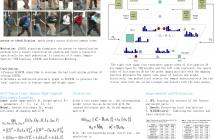
- Read more about Summarization of Human Activity Videos Using a Salient Dictionary
- Log in to post comments
Video summarization has become more prominent during the last decade, due to the massive amount of available digital video content. A video summarization algorithm is typically fed an input video and expected to extract a set of important key-frames which represent the entire content, convey semantic meaning and are significantly more concise than the original input. The most wide-spread approach relies on video frame clustering and extraction of the frames closest to the cluster centroids as key-frames.
- Categories:
 15 Views
15 Views
- Read more about Multimodal Stereoscopic Movie Summarization Conforming to Narrative Characteristics
- Log in to post comments
Video summarization is a timely and rapidly developing research field with broad commercial interest, due to the increasing availability of massive video data. Relevant algorithms face the challenge of needing to achieve a careful balance between summary compactness, enjoyability and content coverage. The specific case of stereoscopic $3$D theatrical films has become more important over the past years, but not received corresponding research attention.
- Categories:
 11 Views
11 Views- Read more about MULTI-VIEW NETWORK-BASED SOCIAL-TAGGED LANDMARK IMAGE CLUSTERING
- Log in to post comments
The multiple types of social media data have abundant information, but learning multi-modal social data is challenging due to data heterogeneity and noise in user-generated data. To address this problem, we propose a multi-view network-based clustering approach that is robust to noise and fully reflects the underlying structure of the comprehensive network. To demonstrate the proposed approach, we experimented with clustering challenging tagged images of landmarks.
- Categories:
 5 Views
5 Views- Read more about POINT DENSITY-INVARIANT 3D OBJECT DETECTION AND POSE ESTIMATION
- Log in to post comments
For 3D object detection and pose estimation, it is crucial to extract distinctive and representative features of the objects and describe them efficiently. Therefore, a large number of 3D feature descriptors has been developed. Among these, Point Feature Histogram RGB (PFHRGB) has been evaluated as showing the best performance for 3D object and category recognition. However, this descriptor is vulnerable to point density variation and produces many false correspondences accordingly.
- Categories:
 17 Views
17 Views- Read more about A Pool of Deep Models for Event Recognition
- Log in to post comments
This paper proposes a novel two-stage framework for event recognition in still images. First, for a generic event image, deep features, obtained via different pre-trained models, are fed into an ensemble of classifiers, whose posterior classification probabilities are thereafter fused by means of an order induced scheme, which penalizes the yielded scores according to their confidence in classifying the image at hand, and then averages them. Second, we combine the fusion results with a reverse matching paradigm in order to draw the final output of our proposed pipeline.
- Categories:
 5 Views
5 Views- Read more about A Pool of Deep Models for Event Recognition
- Log in to post comments
This paper proposes a novel two-stage framework for event recognition in still images. First, for a generic event image, deep features, obtained via different pre-trained models, are fed into an ensemble of classifiers, whose posterior classification probabilities are thereafter fused by means of an order induced scheme, which penalizes the yielded scores according to their confidence in classifying the image at hand, and then averages them. Second, we combine the fusion results with a reverse matching paradigm in order to draw the final output of our proposed pipeline.
- Categories:
 7 Views
7 Views- Read more about Learning a Cross-Modal Hashing Network for Multimedia Search
- Log in to post comments
In this paper, we propose a cross-modal hashing network (CMHN) method to learn compact binary codes for cross-modality multimedia search. Unlike most existing cross-modal hashing methods which learn a single pair of projections to map each example into a binary vector, we design a deep neural network to learn multiple pairs of hierarchical non-linear transformations, under which the nonlinear characteristics of samples can be well exploited and the modality gap is well reduced.
- Categories:
 64 Views
64 Views
- Read more about SELF-PACED LEAST SQUARE SEMI-COUPLED DICTIONARY LEARNING FOR PERSON RE-IDENTIFICATION
- Log in to post comments
Person re-identification aims to match people across disjoint camera views. It has been reported that Least Square
Semi-Coupled Dictionary Learning (LSSCDL) based samplespecific SVM learning framework has obtained the state of
the art performance. However, the objective function of the LSSCDL, the algorithm of learning the pairs (feature, weight)
dictionaries and the mapping function between feature space and weight space, is non-convex, which usually result in
- Categories:
 9 Views
9 Views- Read more about LEVEL-SET FORMULATION BASED ON OTSU METHOD WITH MORPHOLOGICAL REGULARIZATION
- Log in to post comments
Noisy image segmentation is one of the most important and challenging problem in computer vision. In this paper, we propose a level set segmentation technique inspired by the classic Otsu thresholding method. The front propagation of the proposed level set based method embeds a cost function that takes into account first-order statistical moments. In order to deal with highly noisy images, we also added a morphological step to our algorithm which led the final segmentation more robust and efficient.
- Categories:
 23 Views
23 Views- Read more about Part Based Fine-grained Bird Image Retrieval Respecting Species Correlation
- Log in to post comments
poster.pdf
- Categories:
 3 Views
3 Views